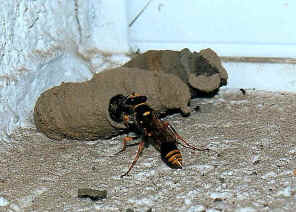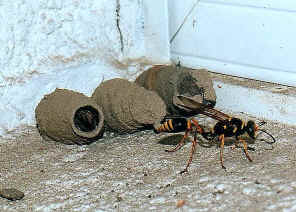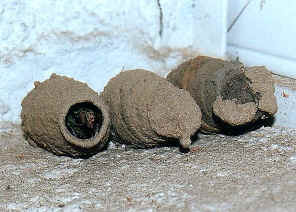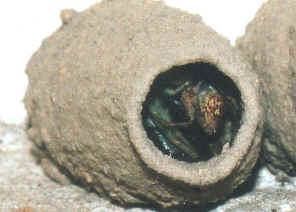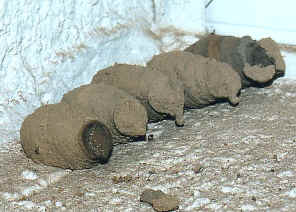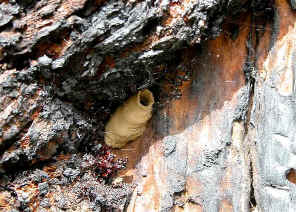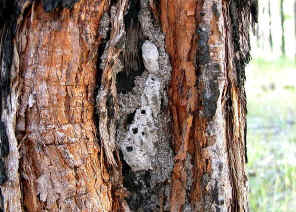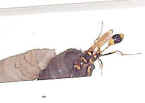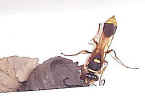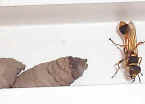|
|
Common Mud-Dauber Wasp - Sceliphron formosum
FAMILY SPHECIDAE
- This page contains pictures and information about Common Mud-Dauber Wasps that we found in the Brisbane area, Queensland, Australia.

- Length 22mm
This Mud-Dauber Wasps are also known as Slender Mud-nest Builders. They are solitary and build nests with pellets of mud. They are common around Brisbane. The wasps are dark brown in colour, with yellow banded abdomen. There is yellow spots on their thorax. Mud-Dauber Wasps have the common characteristic of all wasps - the narrow waist in the middle of their body, and theirs are exceptionally long.
The wasps build mud cells in sheltered locations. If the cell is opened, you will find a wasp larva, together with some spiders which are the larva's foods. They are collected by the mother wasp.
It is the female wasp alone to build those nest cells. The mother wasp brings a full mouthful of mud each time to build the pot like nest cell bit by bit. Then put in food, lay an egg and close the nest cell. The wasp takes about one to two days to complete a cell, which includes building the pot, finding enough food, laying egg and sealing the pot. The mother wasp works in the day time and rest somewhere near by at night time. If she cannot finish the job before sunset, she will seal the unfinished cell temporarily. She re-opens the cell and continues the job on the next day. The small mud disk on the flood shown in the above pictures was used to temporarily seal the nest cell.
The second picture above shows the mother wasp found an ant wandering near her mud cells, she quickly picked up the ant and thrown it away.
The mother wasp feeds her young with spiders. She finds those jumping spiders amongst plants, paralyzes them and puts them inside the mud cell. The wasp stings the spiders to paralyze them. Those spiders are the food of her larva. There are about three spiders in each cell. The mother wasp will lay one egg for each cell before sealing it.
The wasp usually will build five to seven mud cells on the same spot. It will take the wasp about a week to finish the job, depend on weather. We found that when it is raining, the wasp stop working. This could be due to no spiders can be found.
Notice that the wasp build the first mud cell (closest to the window) look not very good. We can see her pot building skill is improving. Although the mud cell building skill is an instinct, this can be improved by more practice.

Finally, the wasp builds 13 mud cells in about two weeks, which is more than usual that we had ever seen. Notice that she covered the cells on the outside edge with extra mud, which could be used as the decoy. After the cells are built, the mother wasp will never return. A few weeks later, we checked that only eight of them hatched. The other five cells never opened.
- In the wild, Mud-Dauber Wasps build their mud cells on tree trunk or rock with shelter.
- There is another species of Mud-Dauber Wasp S. laetum that look similar to the common Common Mud-Dauber Wasp S. formosum. They build similar shape mud cells, however, S. laetum builds cells covered with extra rough layers of mud while S. formosum build simple clusters of cells. In Brisbane, the S. formosum is more common than the S. laetum.
- (Note: After more observations, we may rather to say that S. laetum covers cell with extra layers after each cell is built while S. formosum covered cells after ALL cells are built. We did recorded this in the S. formosum page. S. formosum's cells usually found uncovered just because most wasps may not last long enough to build all cells they want to build. Nature is tough.)
Development of a Mud-Dauber Wasp
On early summer, we find another Mud-Dauber Wasp building mud cells on the wall outside our window.
We opened the cell and recorded the development of the wasp larva.
- 26/11/00
- We carefully collect one, open it and find one jumping spider and two smaller wolf spiders inside. The jumper spider body sizes are 10mm. The two wolf spiders size are 6mm. All spiders seem dead, or at lease not moving. We also found a wasp egg which is yellow-orange in colour. The size is 3mm x1mm. The egg is attached to the body of one of the spider. We carefully put it as original inside a glass box to watch the wasp larva development. When not watching, we cover the box with a card to keep the cell in darkness.
-
-

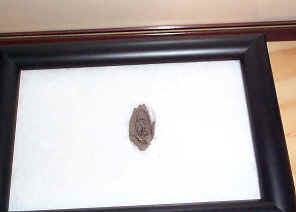
- 29/11/00
- Nothing changed except the egg becomes darker in colour.
-
- 30/11/00
- Segments can be seen on the egg. It has been changed into a larva, although no head or legs can be seen. It is creamy yellow in colour. It seems move a little bit. The spider body which attached to reduced a little bit.
-
- 01/12/00
- It definitely becomes a larva. But no egg shell can be seen. The larva grow very fast. It become 5mm in length and grey in colour. It had finish the first spider which attached to. It start feeding on the second small spider. The big spider has nothing change. Still not moving, no reduce in size.
-
- 02/12/00
- The larva become 8mm in length, white grey in colour. It feeds on all spiders abdomen first. Now all spiders abdomen reduced to minimum. It start to feed on the legs of the three spiders. It is quite active moving between the three spiders' bodies.
-
- 15/12/00
- The Larva become 15mm in length, white in colour. It start to become a cocoon. The cocoon is 15mm in length. It is white in colour and is transparent
- 01/01/01
- The cocoon becomes darker and darker in colour, we can see the wasp inside.


- 15/01/01
- The wasp come out, we open the glass frame and let it come out. The body length of the wasp is 22mm, black with yellow pattern on thorax and yellow banding on abdomen. It has the very slender waist.
- We recorded another species of Potter Wasps, they look similar but build different style of mud nest and capture caterpillars instead of spiders for their young. More information on this page.
- We found another Mud-Dauber wasp S. laetum which builds similar mud nest but with the extra embellishment on top, detailed in this page.
- Initially we identified this wasp as Sceliphron laetum, Graeme Cocks in Townsville send us email and advised that this wasp is Sceliphron formosum, as in "Insects of Australia", the single mud nest is attributed to S. formosum and a multiple mud nest with the extra embellishment on top to S. laetum. We checked and agreed with Graeme. Later we found the multiple mud nest wasp S. laetum. Details please find in this page.
- Reference:
- 1. Scelephron laetum, Mud Dauber Wasp - Insects of Townsville, Australia, Graeme Cocks, 2004
- 2. Wildlife of Greater Brisbane - Ryan, Michelle (ed.), Queensland Museum, Brisbane, 1995, p116
- 3. Wasps of the genus Sceliphron (Hymenoptera: Sphecidae) intercepted in New Zealand - A. C. HARRIS Otago Museum, 1992
- 4. Insects of Australia, CSIRO, Division of Entomology, Melbourne University Press, 2nd Edition 1991, p 990.
- 5. Insects of Australia and New Zealand - R. J. Tillyard, Angus & Robertson, Ltd, Sydney, 1926, p301.
